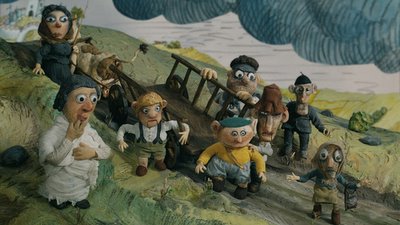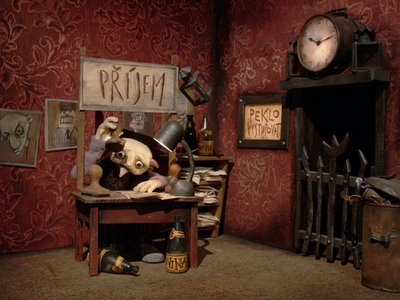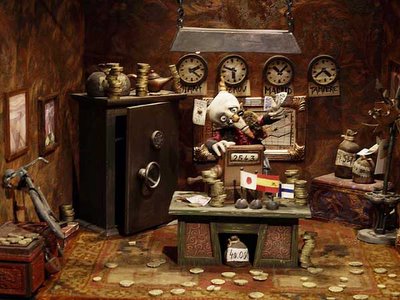Fimfárum
The other night, I joined Alex, Nathan, Kelly, and Andrea (from the Fulbright office) at a showing of Fimfárum II, the second film of Jan Werich’s fairytales.
I am most familiar with Werich as half of V+W (Voskovec and Werich); V+W and their work with the Liberated Theater (Osvobozené Divadlo) are part of the legend of First Republic Czechoslovakia, and come into my dissertation research to some extent because they were part of the larger group of people I deal with and because Jindřich Štyrský was briefly the designer for the Liberated Theater.
Werich, however, had a long career subsequent to the Liberated Theater, and one of his projects was to write a collection of fairytales, which at some point he also recorded. Consequently, well after his death it was possible for Czech puppet animators not only to film the stories, but to use Werich himself as narrator.
Each film is comprised of several tales, with each tale prepared by a different group of animators. While there are some differences in visual style between the different stories, the overall look is consistent, which I think is desirable in a project of this type.
Alex had screened the DVD of Fimfárum I for us at Velké Bílovice, so we were familiar with the project. In fact, as Alex had visited the Aurel Klimt studio during the filming of his contribution to Fimfárum II, and as the DVD had plenty of footage of interviews with the various animators, we knew a reasonable amount about how it is all done and who was involved.
While Fimfárum II has no subtitles, we were all able to enjoy it despite our varying knowledge of Czech. I found two of the tales relatively easy to follow and the other two somewhat mystifying. In the case of the difficult ones, I followed much of what was going on but missed out on some key information or only figured it out at the end. In any case, the liveliness of the animation and the wonderful small humorous details (for instance, the clock giving the time in Žižkov, or the children watching Batman on TV) were really fun to watch. And there will, of course, be subtitles once the movie is released on DVD.

Following the movie, the American contingent decided that this was the only time of year we could safely visit that brewery beloved of German tourists, U Fleku. (Not everyone in the group had been there on brewery tours.) As it was, the music was still a bit overpowering (especially when the performers insisted on playing next to us) and the staff still assumed we knew no Czech, but I suppose it was worth doing once, although I must say I think touring the brewery is more interesting than eating there. After awhile, we decided we had had enough of that experience and moved on to U Sudu, which is always kind of fun if only because it is like sitting in some sort of medieval catacomb. We did not stay out very late, however. There was no need to think about night trams.


I am most familiar with Werich as half of V+W (Voskovec and Werich); V+W and their work with the Liberated Theater (Osvobozené Divadlo) are part of the legend of First Republic Czechoslovakia, and come into my dissertation research to some extent because they were part of the larger group of people I deal with and because Jindřich Štyrský was briefly the designer for the Liberated Theater.
Werich, however, had a long career subsequent to the Liberated Theater, and one of his projects was to write a collection of fairytales, which at some point he also recorded. Consequently, well after his death it was possible for Czech puppet animators not only to film the stories, but to use Werich himself as narrator.
Each film is comprised of several tales, with each tale prepared by a different group of animators. While there are some differences in visual style between the different stories, the overall look is consistent, which I think is desirable in a project of this type.
Alex had screened the DVD of Fimfárum I for us at Velké Bílovice, so we were familiar with the project. In fact, as Alex had visited the Aurel Klimt studio during the filming of his contribution to Fimfárum II, and as the DVD had plenty of footage of interviews with the various animators, we knew a reasonable amount about how it is all done and who was involved.
While Fimfárum II has no subtitles, we were all able to enjoy it despite our varying knowledge of Czech. I found two of the tales relatively easy to follow and the other two somewhat mystifying. In the case of the difficult ones, I followed much of what was going on but missed out on some key information or only figured it out at the end. In any case, the liveliness of the animation and the wonderful small humorous details (for instance, the clock giving the time in Žižkov, or the children watching Batman on TV) were really fun to watch. And there will, of course, be subtitles once the movie is released on DVD.

Following the movie, the American contingent decided that this was the only time of year we could safely visit that brewery beloved of German tourists, U Fleku. (Not everyone in the group had been there on brewery tours.) As it was, the music was still a bit overpowering (especially when the performers insisted on playing next to us) and the staff still assumed we knew no Czech, but I suppose it was worth doing once, although I must say I think touring the brewery is more interesting than eating there. After awhile, we decided we had had enough of that experience and moved on to U Sudu, which is always kind of fun if only because it is like sitting in some sort of medieval catacomb. We did not stay out very late, however. There was no need to think about night trams.



2 Comments:
Hi, nice blog site here.
Please allow me to ask you such this question about Jan Werich, but I'd like to. Question is that;
"What's the question do you ask for him on the interview if he's still alive in the present?"
Thanks for asking. I'm afraid my answer will be dull, because I would first ask Jan Werich about Toyen.
Naturally, I'd also like to ask him about himself and his work, but first I would want to read the many books that have been written about him and see all of his films! After all, I would not like to ask him something that any book could have answered for me.
Post a Comment
<< Home